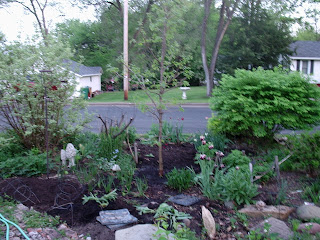OH! The black locust has such an enveloping, wonderful scent! I look forward to its bloom every year. It is a wonderful garden tree in that it grows FAST but strong; provides dappled light; offers interest in the way of bark (older trees), leaves, flowers, and generally inedible bean shaped fruit; it has a narrow canopy footprint, and the leaves are small enough to leave where they land. The problem comes in their aggressive seedlings. This tree has quite a few offspring every year and they will not be denied! The saplings are very thorny (they lose their thorns as they get older) and the entire root must be dug out to get rid of them. You could also let them grow until they are an inch or two thick and cut them down, but even then the tree will try to sucker. They actually are much easier to remove than elm, though. I spent an hour yesterday cutting elm sapling out of my lilac bush - and I will have to do it again and again because I can not dig out the root where they are.
I have not noticed any scent with it, but the shrub is beautiful enough.
They are not necessarily easy to grow, no matter what you hear. The majority of the other variegated dogwood around town look pretty shabby. Other than a fertilizer spike at planting (which I do with most of my shrubs) I didn't do anything special with this one, I guess I just got lucky.
If you give this a try, I would suggest growing it in full sun as I have noticed about the other variegated dogwoods around town, the more shade they get, the less happy they look.

 One plant that really doesn't mind a little shade is the columbine. Several years ago I started some Barlow columbine from seed. I originally had four plants. They weren't too keen on exactly where I had planted them (a little too close to the pine, I'm guessing) and one by one they died over a two year period. The spring after the last died, a couple of their offspring showed up. And now I get new ones every year.
One plant that really doesn't mind a little shade is the columbine. Several years ago I started some Barlow columbine from seed. I originally had four plants. They weren't too keen on exactly where I had planted them (a little too close to the pine, I'm guessing) and one by one they died over a two year period. The spring after the last died, a couple of their offspring showed up. And now I get new ones every year.These are just two of the Barlows that I have this year. My husband and I remembered the columbine munchers from last year and were right on top of them this year. I squished them right on the leaves while they were still tiny. They didn't stand a chance.
 Here is the rodgersia with it's flower. Not a real impressive flower, but it's the leaves that I want. This plant at maturity will be about hip high. Not as big as the astilboides (which I just found out is related to the rodgersia), but still a very interesting plant.
Here is the rodgersia with it's flower. Not a real impressive flower, but it's the leaves that I want. This plant at maturity will be about hip high. Not as big as the astilboides (which I just found out is related to the rodgersia), but still a very interesting plant.I want to get a mass of them growing to help fill in the Asian shade garden that we are expanding. Again, it is not meant to be a true Japanese or Chinese garden, it is merely inspired by them; Fusion, as my husband calls it. And hopefully it will be an inspiration in its own right.
 This is the work that I did yesterday. It was supposed to rain all day, so I got up started my runs to the compost center as soon as they opened at 8am and figured that I would just get loads until it started to rain. I was able to get enough to lay out the whole garden. My idea here was a Taoist theme of "going with the flow". I think out of all the philosophies that I have studied, Taoism makes the most sense. If you have not read The Tao of Pooh I highly recommend it.
This is the work that I did yesterday. It was supposed to rain all day, so I got up started my runs to the compost center as soon as they opened at 8am and figured that I would just get loads until it started to rain. I was able to get enough to lay out the whole garden. My idea here was a Taoist theme of "going with the flow". I think out of all the philosophies that I have studied, Taoism makes the most sense. If you have not read The Tao of Pooh I highly recommend it.The path is a river, an old river, the kind of river that has over the years gone from rushingly trying to push its way through the world to gently and wisely finding its way through. It is not concerned with the speed of the journey, it values the journey itself. This river guides those traveling it through the garden slowly so that they may enjoy the journey too.

























